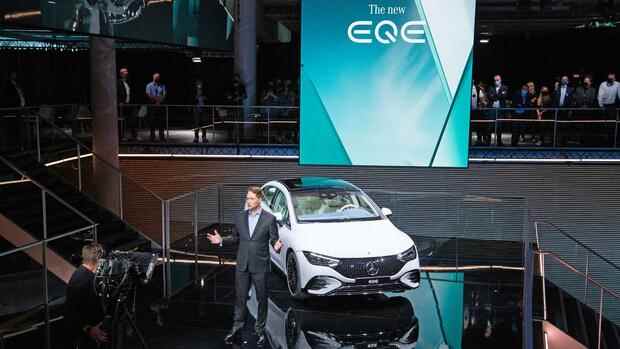Munich At the end of February, Mercedes boss Ola Källenius proudly addressed his 130,000 followers on LinkedIn. “Our internal data shows that in 2021 we will have undercut our provisional regulatory targets for average new vehicle fleet emissions in Europe,” said the Swede happily.
In concrete terms, this means that the Stuttgart-based carmaker was able to reduce emissions of climate-damaging carbon dioxide in its fleet in the EU, Norway and Iceland to 115 grams per kilometer. The reason for this is the increasing sales of electric cars. The individual specification for Mercedes-Benz in 2021 was average emissions of 125 grams of CO2 per kilometer. The Dax group is now complying with the laws applicable in Europe.
“Of course, that’s no reason to rest. But a clear sign that we are on the right track,” emphasized Källenius. What the manager fails to mention: the green transition of the brand with the star is not being carried out as resolutely as in Europe. In China and the USA, the Swabians again failed to meet the climate targets on their own. This emerges from the annual report of the Dax group published on Friday.
Accordingly, Mercedes “did not meet” its fleet targets in the United States for both its passenger cars and its vans. According to the “Greenhouse Gas” standard, or GHG for short, the Stuttgart-based company should actually have emitted a maximum of 194 grams of CO2 per mile with their sedans and SUVs in the 2021 model year. In reality, however, the average fleet value of Mercedes in the USA last year was 251 grams per mile.
Top jobs of the day
Find the best jobs now and
be notified by email.
For small vans, the GHG specification was 259 grams. In fact, the Mercedes van fleet emitted 296 grams per mile. The situation in China is hardly any better, by far the largest sales market for the Stuttgart-based company. There, the fleet of imported vehicles should consume a maximum of 7.16 liters per hundred kilometers on average. In fact, the consumption of the import fleet from Mercedes was 8.24 liters.
Pollution rights cross-finance greener competitors
To avoid impending penalties, Mercedes uses a legal trick. The group buys so-called pollution rights from third parties, such as pure electric car manufacturers. With the help of these CO2 certificates, Mercedes can noticeably improve the climate balance of its own vehicle fleet, which still consists mainly of combustion engines.
In the USA, the Swabians have already “closed” the difference between their own fleet values and the legal requirements by acquiring “external credits”. In China, the group wants to acquire pollution rights “to cover short-term consumption gaps in the fleet target achievement”, according to the annual report.
>>> Also read: The ten most popular electric cars of 2022
This practice has met with criticism. “The financial burden for Mercedes from the purchase of CO2 certificates is small, but the procedure entails risks for the reputation of the group,” complains Ingo Speich, Head of Sustainability and Corporate Governance at Deka Investment. “Ultimately, you strengthen competitors like Tesla, who are happy about compensation payments,” explains the expert from the fund subsidiary of the savings banks.
In order to achieve the CO2 targets on its own, Mercedes would have to sell more electric cars in the future. At least during operation, the Stromer do not emit any carbon dioxide. The share of purely electric models in total sales is still only 4.1 percent. Last year, the Swabians sold 99,000 all-electric cars and vans. Deliveries totaled 2.4 million vehicles.
Stromer sales in the USA are just starting
From the shareholder’s point of view, Deka manager Speich can understand that the ramp-up of electromobility has to be financed and that Mercedes cannot electrify its entire fleet overnight. “The goal in China of only complying with the emission specifications on its own in the medium term is not very ambitious,” criticizes Speich. He appeals to the group to close the CO2 gaps more quickly.
In principle, the CEO Ola Källenius is ready for a quick conversion. By 2025, half of all new cars should be electrified. And by the end of the decade, Mercedes aims to only sell purely electric cars, provided the charging infrastructure allows it. So far, the Stuttgart-based company has been pushing its electricity offensive, especially in Europe. The CO2 requirements are particularly strict here and there are severe penalties if you miss the target.
However, the strong EU focus on electric sales means that Mercedes continues to be one of the weakest in the class when it comes to climate protection in the USA and China. Especially since the group is boosting sales of models in these markets that consume a lot of fuel. These include the G-Class off-road vehicle, the high-powered cars from the AMG tuning subsidiary and the products from the luxury brand Maybach.
The Swabians didn’t even offer the EQC, the first electric SUV from Mercedes, in the USA. The group is now trying to bring more and more pure electric cars overseas and in the Far East. The EQS SUV and later the EQE SUV will soon be rolling off the assembly line in the United States. In addition, the start of sales of the EQE, i.e. the electric E-Class, is imminent. The luxury sedan is one of the most important volume models from Mercedes.
More: Mercedes boss Ola Källenius now earns 6.1 million euros
